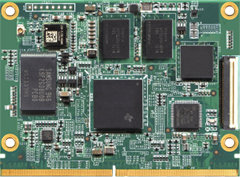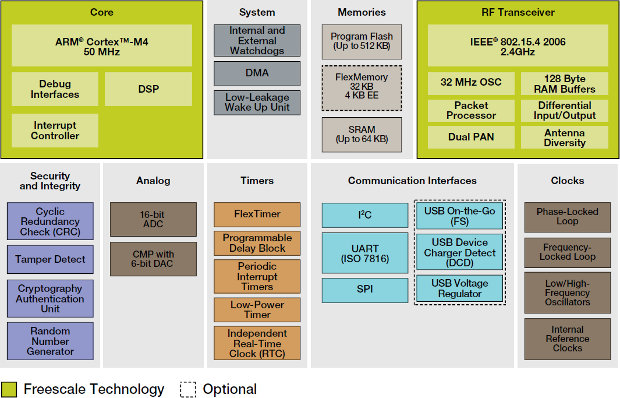ARM unveiled its ultra-low power Cortex-M0+ core back in March, and Freescale and NXP also announced their plans to use this new core in some of their micro-controllers destined to power the internet of things. Yesterday at Freescale Technology Forum (FTF), Freescale announced the availability of alpha samples of its Kinetis L series. This new low power MCU family will allow existing 8-bit and 16-bit architecture to be replaced by 32-bit architecture without increasing power consumption, cost or size, and the company expects them to be used in devices such as small appliances, gaming accessories, portable medical systems, audio systems, smart meters, lighting and power control. The ARM Cortex-M0+ processor is said to consume about a third of the energy of any 8- or 16-bit processor, while delivering between two to 40 times more performance. Kinetis L series MCU can consume as low as 50 uA/MHz in very-low-power run (VLPR) […]
Getting Started with Emcraft Systems Cortex M3/M4 Starter Kits Running uCLinux
A few months ago, I wrote a post about running uCLinux on Cortex M3/M4. Since then I’ve had the opportunity to play a with Cortex M3 & M4 boards capable of running Linux, as last week, I received Emcraft Systems Freescale K70 Starter Kit together with their MicroSemi (previously known as Actel) Smartfusion SoM. Today, I’ll show some pictures of the baseboard and modules I received in the kit, and some details about the documentation and how to get started with the modules. Unboxing Pictures Here’s the baseboard with Ethernet, USB interface using USB-UART bridge connected to the UART0, JTAG connectors (P3 and P5), two push-buttons and a breadboard for easy access to unused signals (ADC, I2C, SPI, UART and GPIOs). P4 and P6 are the sockets to plug in the SoM. There is a lithium-ion battery (CR2016) at the back of the board for the RTC clock. As previously […]
TechNexion EDM Modules: Open Software and (somewhat) Open Hardware ARM & x86 CPU Modules
TechNexion, a Taiwanese “embedded solution” company, was present at Computex 2012 showcasing their ARM & x86 CPU Modules and corresponding development kits. The company recently created the EDM Standard, an open hardware and software standard for x86 and ARM Computer on Modules available under the creative commons share alike license. Their EDM modules come in three form factors: EDM Compact: 82 x 60 mm (ARM only) EDM Standard: 82 x 95 mm (ARM and x86) EDM Extended: 82 x 145 mm (x86 only) They have already designed 5 modules based on this standard: EDM-CF-iMX6 EDM Compact Module powered by Freescale i.MX6 (solo, dual or quad) EDM-CT-AM437x EDM Compact Module powered by TI Sitara AM437x (single core Cortex A9) EDM-SF-iMX6 EDM Standard Module with Freescale i.MX6 EDM-ST-AM437x EDM Standard Module with TI Sitara AM437x EDM-XI-QM77 EDM Extended Module with Intel QM77 3rd generation i3/i7 core I could not find information about […]
Freescale 12-axis Xtrinsic Sensor Platform Technology for Windows 8 / RT
Freescale announced the Xtrinsic Sensor Platform, a 12-axis sensor development reference platform for Windows 8. This 12-axis sensor platform includes several sensors by Freescale and other companies: Xtrinsic MMA8451Q 3-axis accelerometer Xtrinsic MAG3110 3-axis magnetometer Xtrinsic MPL3115A2 precision altimeter, pressure, and temperature sensor An analog ambient light sensor A selection of 3D gyroscopes are also supported This platform is powered by Freescale ColdFire+ MCF51JU128VHS MCU which combines, configures and processes sensor data with Freescale sensor fusion software to match the requirements of Windows 8/RT. Xtrinic sensor platform communicates with the host device via USB. It does not requires extra drivers as it uses standard HID drivers. You can watch the video below which is an introduction (including some technical details) and demo of the system. Strangely, I could not find a similar Freescale 12-axis reference design for Android or Linux, and I’m not sure why they would limit this hardware […]
Freescale Announces Kinetis KW20 Cortex M4 MCU with Built-in Zigbee Transceiver
Freescale announced the addition of the Kinetis KW20 to its Kinetis microcontroller portfolio. The Kinetis KW20 is based on ARMCortex-M4 core and MC13242 RF transceiver to deliver a single chip Zigbee solution for the Internet of Things and power applications such as smart energy, smart metering and building control. The company explains that their new wireless MCU family aims to “address the increased processing and memory requirements associated with future ZigBee Smart Energy 2.0 and Internet Protocol specifications”. The KW20 supports dual personal area network (PAN) to enable a single device to communicate wirelessly on two ZigBee networks. This feature eliminates the need for multiple radios required to connect different home automation and smart energy networks. Kinetis KW20 wireless MCU features: ARM Cortex-M4 processor core Up to 512 KB of flash memory and 64 KB of RAM Cryptology accelerator and sophisticated tamper detect Integrated IEEE 802.15.4-compliant radio (MC13242 RF transceiver) Low […]
VWorks VLAB Powers Freescale Vybrid Virtual Platform
Back in March, Freescale announced their Vybrid solution featuring both a Cortex A5 processor and a Cortex M4 microcontroller, and they had prototypes running an unnamed virtual platform in order to speed up software development and possibly have the software ready at the same time as the silicon is. Always looking to learn more, I studied and wrote about virtual hardware platforms such as Cadence Virtual System Platform, Wind River Simics Virtual Platforms and the open source Imperas OVPsim simulator. It turns out Freescale does not use any of these solutions, but relies on VWorks VLAB instead, which still use the same standard (SystemC/TLM) as the virtual hardware solutions aforementioned. VWorks uploaded a demonstration of VLAB running a virtual platform for the Freescale Vybrid controller and showing how it can handle both ARM Cortex-A5 and Cortex-M4 cores. This demo of VLAB 1.7.0 is pretty interesting and showcases: Dual (virtual) display […]
Freescale Vybrid Controllers: Cortex A5 + Cortex M4 Solutions
Freescale announced the new Vybrid platform based on Cortex A5 application processor and Cortex-M4 MCU (VF6xx and VF7xx family only) which targets building/home automation and control, industrial automation, point-of-sale systems, medical devices, smart energy equipment, and appliances. There are 5 families of Vybrid Controllers which support the following common features: Video/Camera Interface Unit + optional OpenVG GPU (except VF3xx) Up to 800 MHz data rate DDR3 and LPDDR2 support (except VF3xx) USB 2.0 OTF with Integrated PHY (1 or 2 depending on model) Ethernet 10/100 MAC (1 or 2 depending on model) Display controller (WQVGA to XGA resolutions) High-assurance boot with Crypto Acceleration Up to 1.5 MB on chip SRAM NAND Flash controller and Dual Quad-SPI with eXecute-In-Place(XIP) Dual 12-bit ADC and DAC Here are the 5 families of Vybrid platforms and key differentiating features: VF3xx: ARM Cortex-A5 up to 266 MHz, 1x USB 2.0 OTG, 2x Ethernet, display up […]
FSLBOT: Freescale (Dancing) Robot Kit
Freescale unveiled the FSLBOT prototype last year (and I missed it!), and today, the company has announced further improvements to the Freescale Tower System mechatronics robot and board, a bipedal robot and development board that allows designers to write software for a variety of sensor applications while making a robot walk and respond to touch, motion, vibration, tilt and other external stimuli. The new version of the robot uses a new programming language based on StickOS, has wireless capabilities and adds an Xtrinsic MAG3110 magnetometer. This robot has been designed with the collaboration of StickOS and CPUStick.com with the goal “to create a tool that would enable casual users and consumers of technology to become creators and innovators”. The Freescale FSLBOT Robot Kit comes with the following: Freescale Tower System mechatronics board powered by a 32-bit ColdFire MCU with 64K of RAM and 512K of flash. Leg mechanics and associated […]










